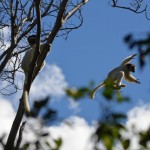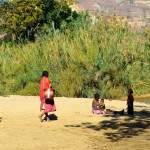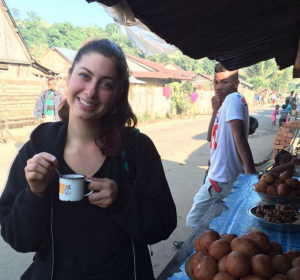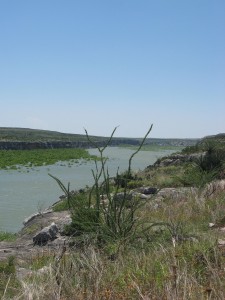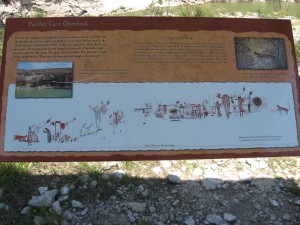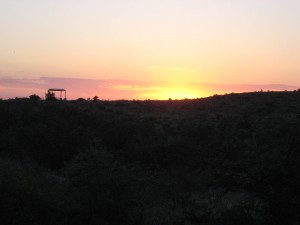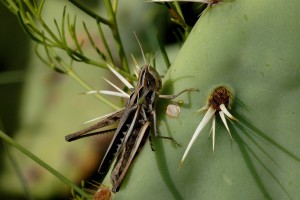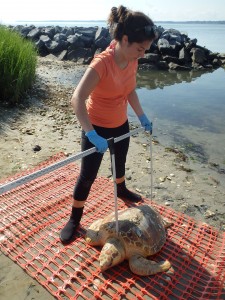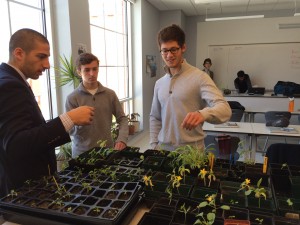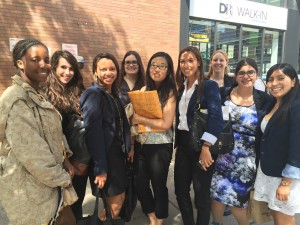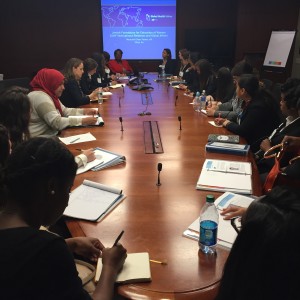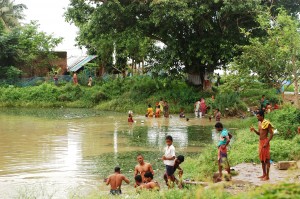You can also view our blog on the School of Marine and Atmospheric website:
Students to Study Human Use Patterns at Ashley Schiff Park Preserve
When Margaret Conover asked the Sustainability Studies Program if we could quantify use-patterns in the Ashley Schiff Park Preserve, two Environment and Human Impact students enthusiastically said yes!
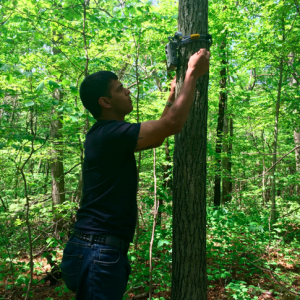
Photo 1. Student Andrew Fiorenza hangs a camera trap in the Ashley Schiff Park Preserve. He received funding from the Friends of Ashley Schiff to conduct this project.
With the help of Dr. Sharon Pochron, students Alexandra VanLoo and Andrew Fiorenza wrote a proposal to hang camera traps and count the number of heads that had shown up in the photos. They want to collect data for a full year to get an idea of how people use the park during all seasons. With excitement, the Friends of Ashley Schiff Park Preserve approved of their proposal, providing the funds necessary to complete this study .
Alex and Andrew have already purchased the cameras and hung them at the trailheads. Despite abundant amounts of rain, they have managed to get the perfect angles for the cameras to snap photos just as people pass the park entrance. In addition to the technical work, they have read multiple sources of prior studies regarding methods that other parks have used to assess human-use patterns. Working in conjuction with Dr. Pochron, they plan to quantify park use with the addition of displaying how use changes with season. They plan to present their results at next spring’s URECA.
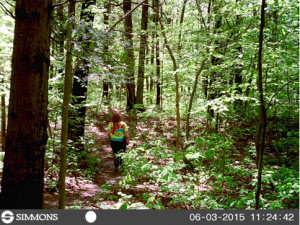
Photo 2. Photographic data from camera trap. The cameras take pictures of people as they pass into the park. This camera-trap photo shows Alex VanLoo, who received funding from the Friends of Ashley Schiff, entering the park.
The scholarships for Alexandra VanLoo and Andrew Fiorenza will be awarded at Friends of Ashley Schiff Park Preserve annual Membership Reception from 5:30 to 7:30pm, Thursday, September 24 at the Simons Center. Carl Safina is the invited guest speaker. If you would like to attend this reception, you must join the membership for the Friends of Ashley Schiff Park Preserve. Membership is free and open to all, so don’t hesitate to sign up today! Click here to R.S.V.P. for the reception. See you there!
Sustainability Studies Program spends another summer in Madagascar!
How did you spend your summer? In late May, Dr. Heidi Hutner, professor and director of the Sustainability Studies Program at Stony Brook University, packed up and headed to Madagascar! There, she assisted with the travel abroad program by teaching alongside Dr. Patricia Wright of SBU’s Department of Anthropology.
On the trip, Hutner and her students traveled all over Madagascar. They visited Dr. Wright at Centre Val Bio, in Ranomafana National Park; where they hiked, learned about lemurs and other animals native to the tropical rainforest, as well as about conservation and sustainability issues. Additionally, they hiked in the Isalo National Park and Anje Preserve, snorkeled off Tuléar, met with the ocean conservation “Reef Doctor,” walked through the Spiny Forest, visited schools and hospitals, and more. Along the way, they saw many lemur species, amphibians, snakes, exotic moths, rivers, waterfalls, and beautiful flora and fauna. They met with many Malagasy people and learned about their history and culture.
- Ring-tailed lemurs (Lemur catta) are primates found only on the African island of Madagascar and some small islands nearby. “Because of its geographic isolation, Madagascar is home to many amazing animals found nowhere else on Earth.” (National Geographic)
- Children at a local school.
- Lemurs leaping.
- At school.
- Farming families in Madagascar bring their livestock to a stream to drink.
- Gathering water.
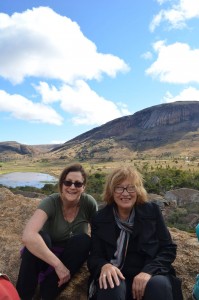
Pictured here: Drs. Heidi Hutner and Pat Wright, at Anja Community Reserve, where they saw many ring-tailed lemurs (Lemur catta) and climbed up high for a beautiful view.
Hutner worked with the students on their writing project and will be writing about Wright’s work on reforestation in articles and in her forthcoming book, Inspiring Green Minds. She and students who attended strongly recommend this travel abroad trip, which is offered in both the fall and summer. It offers something for everyone: budding primatologists, journalists, conservationists, anthropologists, or just curious minds. The Madagascar trip is an unforgettable travel experience.
Dr. Heidi Hutner
Professor and director
Sustainability Studies Program
Stony Brook University
Becoming a true trailblazer: starting a business in Madagascar
I entered into Stony Brook Southampton in 2009, my second year at Stony Brook University – as what the school called a “Trailblazer.” That term always stuck with me, what really made me a trailblazer? This term followed me through my academic career as I tried to figure out what my path would be – and how I would live up to this title.
After graduation, I decided to study abroad in Madagascar with Dr. Patricia Wright of the Department of Anthropology at Stony Brook University. During this program I learned about pressing conservation issues and the strategies of solving them, but I also fell head-over-heels in love with Madagascar. Since that trip I dedicated myself to working there, I knew I had to work there – and after two years of life’s twists and turns, I went back. In the meantime I studied traditional herbal medicine, and took a chance on starting a small homemade cosmetic company- but I still constantly thought about Madagascar.
In Madagascar, 90% of the original forest has been torn down, and 90% of the flora and fauna are endemic. So conservation efforts are absolutely necessary. Madagascar is a wonderland, a true Jurassic Park; and as the story goes once you visit, you will inevitably come back.
Last year, I decided to come volunteer and live in southeast Madagascar for six months to better understand conservation issues and culture. Sometimes, you just have to bite the bullet and take the leap, right? Well, this trip changed my entire perspective on everything – it was truly life-changing. But what I learned was that environmental and conservation issues need to be solved in multiple ways – we need to be innovative in solving these problems. So, I am starting a business here in Madagascar (no, I am not crazy).

Patricia Wright and I are having a meeting with the Association of Traditional Healers in Ranomafana, Madagascar. We are helping them set up a business for selling essential oils – all of which will be used in Ny’Ala Skincare.
Ny’Ala Skincare will be a line of products utilizing the exotic plants of Madagascar for their immense healing properties. Ny’Ala will work with Malagasy only, from the small farmers to local artisans to bring you the entire experience of Madagascar. When buying our products you are combating poverty, giving back to conservation efforts such as reforestation projects in Ranomafana, Madagascar, providing job stability, preventing rainforest destruction and empowering local artisans to keep their traditional crafts alive – all while treating yourself.
My plan for my company is to expand this model of using business as a driving force for real change – the more businesses adhere to models like this – the more real change we will see with pressing global issues such as poverty, hunger and environmental degradation. This is the idea of “Trade Not Aid,” which is providing commerce and trading abilities rather than temporary aid. Social enterprises are now everywhere, and it is so amazing to see capitalism turning into a vector for change. That is being a “Trailblazer” to me – being innovative, and just going for it.
Check Ny’Ala out online at www.Ny-Ala.com and on Instagram @NyAlaSkincare
By Dana Cutolo
Environmental Studies Major
Study Abroad Program in Madagascar
Stony Brook University ’12
Professor Taylor reflects on his summer travels
This summer, Dr. David Taylor, one of our newest faculty members, spent time traveling out west. Below is a blog post he wrote during his experience for the Center for Humans and Nature, a reflection on his experience as a modern-day person navigating a traditionally rugged and natural part of the U.S.
We encourage you to take a read! His work is reposted with permission, below:
Home(page) on the Range?
Seminole Canyon State Park and Historic Site, a few miles from Comstock, TX along the Rio Grande and the Seminole/Presa Canyon
June 3-4, 2015
This past year I took a job at Stony Brook University in Long Island, New York—sorry, I live “on” Long Island, as the locals say, not “in” it. I’ve learned that making a bagel is a fine art, “Howyadoin’?” is one word, and you better have an Express Pay toll tag or $20 in your billfold if you want off the island. My parents had to find Long Island on the map since it’s north of the Mason-Dixon, and more than a few Texas friends offered repetitions of the Pace picante commercial, “New Yawrk City!” Snow is a viable part of winter now, a new experience for me. It was a good year, though, of new friends and a new culture.
Stony Brook is halfway along the north side of the island and is suburban-rural, not the urban Long Island that folks imagine, which is closer to Manhattan. Where I live, the Canada geese honk their way from one river bay to another just above the treeline; white-tailed deer are dangerously plentiful; and the villages along Highway 25A protect their quaint character tooth and claw from big box stores, McDonalds, and additional development. It’s a connected place—folks and critters together on an island, a long one—but an enclosed space nonetheless. Often I longed for open views of unpeopled space, but the forests, quaint villages, and weekend Manhattanites conspired against me. If you want vistas on Long Island, you have to head to a shore and look out onto the ocean. Yes sir, all this has been an adjustment for a newbie New Yorker.
* * * * *
I’m a Texan. I say that knowing it carries a lot of cultural, political, and land use baggage. I’ll leave any discussion of politics alone since current Texas politics baffles me. (No, Governor Abbott, the U.S. military isn’t about to invade Texas. Sigh.)
Despite the oddities, we Texans with long histories in our state do tend to enjoy open, unpeopled land; it’s part of my parents’ lives in west Texas, part of our genealogy, and part of the way we get by. Red dirt, dry canyons, mesquite, coyotes, buzzards, and good stories (with a fair amount of bullshit added) of what goes on upon the open range are as much the core of my heritage as the three-inch-thick, family Bible my mom keeps on the coffee table.
When my summer break from Stony Brook came ‘round, I told everyone, “I’m heading west, just to see open land.” I dropped off my dog with my parents in Dallas and am now traveling from Texas to Washington and back, camping as often as I can. My two-month route is more about friends and places to visit than timeliness, so the path isn’t direct but a sort of wandering with a loose schedule. The goal was to have some time to hike during the day and read and write in the evenings, mostly at campsites but occasionally, when necessary, a cheap hotel.
I hadn’t really wanted to cut off all correspondence, so I added an autoreply to my email:
Hey all,
I am hiking and car camping the west from May 29-August 1. I should have internet access off and on, but it may take me a day or two to respond–at least I hope I’m far enough away from wifi not to respond quickly.
Have a great summer.
Best,
David/Dr. T
I had no idea the irony of that line about WiFi.
My first direction was south and west from Dallas-Forth Worth, visiting friends in the Hill Country and looking over the recent devastating floods along the Blanco River. From there, I headed west to Eagle Pass to visit Carol Cullar, matriarch of all wild things in her area along the Rio Grande. Along the way from Kerrville to Eagle Pass, I lost cell reception, so I also lost Google Maps on my phone to guide me. It was briefly disconcerting, but I knew by heading west, eventually I’d find the Rio Grande and then could drive north or south to my destination.
Strangely, as time passed, it became freeing to see the “No Service” alert on my phone. No calls. No texts that required me to pull over to read. Just good ole west Texas AM radio in English and Spanish, a little norteño music to boot.
* * * * *
I’m 53 years old. Old enough to have been an adult before cell phones, PCs, and the Internet. As a kid, I spent my summers wandering in the woods by my parents’ house with no access to TV, phone, or game devices. As a college student, I typed my undergraduate and some of my graduate papers on a manual typewriter and did library research the old-fashioned way with card catalogues and reference books, some so old they smelled of animal glue. I’ve hiked and backpacked deep into wilderness areas for a week or two with no GPS, phone, or electronic device with me. Hell, I even thought at one time that sleeping pads and flashlights were for the weak. I have read and heard folks who eschew using computers and the Internet to write, take notes, or store pictures because they say it not only cheapens engagement and commitment to the nonhuman world, it severs our relationship. I understand their thoughts.
My Long Island year was good training for discerning the lines between solitude and loneliness, vistas and cramped spaces, breathing deeply and grabbing the cell phone or waiting for the ding of connection. If I was missing my family and bluebonnets in Texas from deep within three feet of northeastern snow in March, I could send a text, ask for a photo, or Skype my way to connection. I could check the weather in Texas (anywhere in the world for that matter), look on webcams to see places I know, read any local paper from any podunk town I wanted.
All of this was comforting in ways not possible thirty years ago, but it was also a lonely comfort. One morning I had to ride the train to Manhattan for a meeting. On the early or evening trains, every seat has a butt in it, but no one talks to the person next to them, unless they know each other. We all had our phones, ear buds, laptops, and tablets out; some were already working but all were certainly disengaging from their peers. When I arrived in New York, I was explicitly told not to talk to folks on the train or subway—“They’ll think you’re crazy.” Keep in mind, public transportation for a Texan is a really communal idea, but, here, the commuters’ coping mechanism for such a moshpit of humanity is only a finger slide and password away.
* * * * *
During my brief, enjoyable stay with Carol, she suggested I camp at Seminole Canyon State Park, only a few miles up the road and home to some of North America’s oldest pictographs (dating back to 7000 BC). I was ready for more hiking and less driving, so I pulled in around noon and asked the ranger if there was an available tent site. He laughed, “Yes, you’re the only one here. And likely to be. Our visitor season is November to April. Too hot and windy these days. Take campsite 13. It’s the best protected from the wind.”
Sure enough, up on the hill of designated campsites, only the wind blew for company and it was already a toasty 92. The Canyon Rim trail is listed as only slightly more than six miles, and there was no time to set up a tent or cook dinner, so I backed the car in, emptied my pack of everything but map, water, and wallet, and took off.
The trail isn’t difficult, no real elevation gain or loss, but in early June it is generally hot and windy. A jackrabbit greeted me at the trailhead before sauntering a few yards to the east, probably used to getting a few nuts thrown its way. It’s a good trail, though, and I was the only one traversing it.
This is what I had longed for during the Long Island winter: vistas, heat, and time to slowly take them in alone. So when I got to the shelter for the Panther Cave interpretive site, I sat for an hour looking across the canyon at a pictograph in the shape of panther. I also took that hour for a respite from the sun and a little solitude.
I think finally a lasting winter chill thawed inside me. The trail’s half-mile along the Rio Grande melted the remnants.
This bit of heat will be around and start the fires I’ll make in the snow and cold of February. Likely, too, this same bit of heat will lead me outdoors with my layers of winter clothing and microspikes to walk down to the beach. As cold as the ocean wind will be, the experience will stoke this fire.
* * * * *
I made my way back in time to set up my tent in the evening, driving the stakes in deep to keep the tent from becoming an untethered blue kite.
I planned to do some writing and editing during my trip, so I also pulled out my laptop and began typing notes and downloading pictures. It was a dusty dusk by then, but the screen glowed brightly in the darkening light. Here, some old essays that need mending. Maybe even a few lines of poetry churned out. Odd, I thought, as the little quarter circles lit up. I have WiFi? No cell service but Texas Parks & Wildlife WiFi? Holy crap! WiFi here … alone … in the boonies … below the meandering buzzards and a curious Harris’s Hawk?
I have to say, I felt baffled. Would I have wanted this experience ten years ago with my young daughter when she and I spent a year camping at no less than nineteen Texas parks? Would she have wanted this virtual connection instead of the books we brought? Would Richard Louv say that such electronic portals are now encouraging “nature deficit disorder”? Would Bob Pyle say having WiFi service is encouraging the extinction of experience with this place?
Damn, I thought, three days since I checked university email. Might as well see how high the work pile has grown. And after thirty seconds of watching the virtual wheel turn round and round, up popped an ugly forty emails waiting for attention. By now, the buzzards and hawk were replaced by a blustery night sky stippled with stars and washed by a full moon in the southeast sky. I wondered then what to do. Should I open them and do work? Should I count the constellations? Should I check the computer to learn more about the constellations in the sky over my head?
* * * * *
Those of us who value our time in other-than-human places face similar questions all the time. Maybe not quite so stark, but just as significant. When and where do we draw lines about respect and real engagement? When do we sever our work and dialed-in habits and ways and use our actual senses to be where we are? When do we allow the virtual world to deny us the actual? Such temptations may be greater in the city, but now we must confront them in some of the most remote areas in the country, as I was finding out.
There’s a part of me that wants TP&W to cut the connection and make folks just be here. Make those kids who’ll be unhappy with no Internet tough it out until they begin to have fun the way I did. Get a cactus thorn or two in your thumb; bloody both knees by running across a wet trail; let a grasshopper you caught spit “tobacco juice” all over your hand. Experience real things.
But I’m also of that generation that spans the advance of the Computer Age, so I wonder if this isn’t my own jeremiad against a modern, connected life. I must admit over half of my scholarly and personal reading is now done online. I have friends who listen to birdcalls and check their Audubon life list by the power of their phones. I Facebook (yes, that’s a verb), but awkwardly, never really sure how much is too much or too little, and, oh yes, we writers love it as free advertising of our new work.
Most folks who have struggled with similar topics retreat to the discussion of tools, efficiency, and work. Am I using this tool with less energy consumption to do a job better and more quickly? Am I using the tool correctly? Am I becoming addicted to using the tool? It’s certainly one way to approach the question, but I wonder if this indicates the perspective of those of us who remember what it was like pre-Internet. For younger people, it may be more of a viewpoint than a tool. My college-age students’ phones, tablets, and laptops are their library, newspapers, gathering places with friends, and even, in some instances, their initial access to other-than-human landscapes via a thousand hits with information and images.
I can only partly grasp that notion; most times, I will still take a grasshopper spitting in my hand and finding a desert willow close by to wipe it on.
* * * * *
All this to say I read half of my emails that night. I answered only those folks I knew were waiting on me for some important response. After that, I also chose to close the computer and turn my eyes toward the night skies and look at the horizons lit by moonlight. Over and above the constant wind, I heard swooshes just above my head. Bats, I smiled and leaned back in my chair, my computer safely stashed in its case. And quite honestly, I tried to grasp the significance of such connections, Internet memes and bats darting just above my head. I wish I could write that I came to a better understanding, but I am less bright than the moonlight was that evening.
Two weeks later into my trip, I’m still sorting through my reflections and choices. I wake up in the morning and try to make conscious decisions about my time—hopefully engaged at every turn. I thought writing this essay would help. I have a better understanding of when and why I need time away, but it’s a long trip, so I’m sure I have more to learn.
By the way, I just finished this essay on my computer in a Starbucks in Logan, Utah. Free Internet enabled me to submit it! (Insert smarmy emoticon.) Now I can go hike the Logan River on a trail just outside of town. I won’t bring my phone or computer with me, so I don’t care if it’s in range or not. I’ll get back to you in a few days.
All photographs by David Taylor, except for”Grasshopper on Cactus” (Big Bend National Park, Texas) by Robbie, Creative Commons license 2.0.
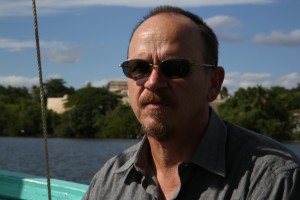 David J. Taylor, Ph.D.
David J. Taylor, Ph.D.
Visiting Professor of Sustainability
Sustainability Studies Program
Studying sea turtles, serving as a mentor in science
Similar to the experience of most undergraduates about to earn their degree, my senior year at Stony Brook University was filled with bittersweet excitement as graduation neared and a new chapter in my life was to unfold. I graduated from SBU in 2014 with my B.S. in Marine Vertebrate Biology and a minor in Ecosystems and Human Impact through the university’s Sustainability Studies Program. For me, the next step after graduation was clear: grad school. Thus, I went on to begin my graduate studies this past fall at the Virginia Institute of Marine Science (VIMS).
Currently a 2nd year masters’ student, I am working under the guidance of Dr. David M. Kaplan to investigate sea turtle stranding events in the Chesapeake Bay. The Chesapeake Bay is a significant foraging and developmental habitat for thousands of juvenile sea turtles, however each year approximately 200-400 deceased sea turtles are found stranded on local beaches. The number of stranding events in Virginia waters has increased substantially over the years, a major concern for the long-term sustainability of turtle populations. For my graduate research thesis, I am using computer models and field drift experiments to determine likely locations of juvenile loggerhead mortality in the Chesapeake Bay. My research will be used to identify possible causes of mortality and highlight areas of focus for conservation.
The experiences I gained during my undergraduate program at Stony Brook University played a vital role in narrowing my passions within the field of marine science. I found many opportunities as a SoMAS student to directly immerse myself in the field, such as through hands-on lab courses on the Stony Brook Southampton campus and study abroad programs at the Discovery Bay Marine Lab, in Jamaica. Throughout my coursework, I began to form an acute awareness of the delicacy of aquatic ecosystems, raising questions about the sustainability of the marine realm. This spurred a desire to strongly integrate conservation in my future endeavors and led me to pursue the Ecosystems and Human Impact minor within the Sustainability Studies Program to supplement my degree.
My position as an undergraduate research assistant during my junior and senior years under the direction of Dr. Bassem Allam was perhaps my most valuable Stony Brook University experience in my development as a scientist. Working closely alongside graduate students, I dug deeper into scientific thinking and research and gained an invaluable look at the dedication and resolve that a graduate education mandates. Greatly inspired by the support and work of those around me, it was through this experience that I decided to pursue research and continue my education at a graduate level.
Today as a graduate student, I strive to form mentor relationships with students interested in pursuing marine science and provide the same encouragement, time and support that the individuals in my early career served me. I have been able to advise my own undergraduate student this summer and am looking forward to serving as a graduate teaching assistant this upcoming year. I am also excited to participate in VIMS’ GK-12 Program this fall, where I will be sharing my research and helping teach in a local middle school classroom.
Fueled by my enjoyment of research and desire to learn, I am thankful for the opportunities I had as a Stony Brook University student and the crucial impact it had on preparing me for this next chapter of my life. I am eager to continue pursuing my career and am excited to see what the future holds!
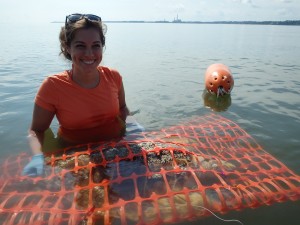 By Bianca Santos
By Bianca Santos
Marine Vertebrate Biology Major
Ecosystems and Human Impact Minor
Stony Brook University ’14
New EDP fall course offering: “Risk Assessment and Sustainable Development” (EDP 305)
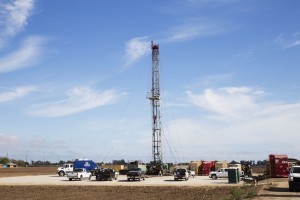
A fracking site sits next to two deep injection wells owned by Anterra, a wastewater injection company, in Oxnard, California. CREDIT: Sarah Craig/Faces of Fracking (flickr)
Are hydraulic fracturing (fracking) residual wastes, now being “legally” disposed of in many of the nation’s sewage treatment facilities, posing unknown threats to the food chain, and thus human health and the ecosystem, as “biosolids” (a by-product of sewage sludge disposal) are routinely dispersed onto arable land with little or no oversight by the regulatory authorities?
This is the basic research question being explored by a new course offered for the first time by the Sustainability Studies Program this Fall. Entitled “Risk Assessment and Sustainable Development” (EDP 305), it will meet Tuesdays and Thursdays, 10:00 AM to 11:20 AM.
As the instructor for this course, I am no stranger to risk assessment. During my seven years with Barry Commoner’s Center for the Biology of Natural Systems at Queens College, I was party to numerous critical evaluations of environmental impact statements (“EIS”). There was among my colleagues a very hard-headed view about these documents. One could observe what too frequently amounted to boiler plate narratives that built off of inaccurate data, shaky methodologies and questionable assumptions to generate startlingly precise numerical representations of estimated human mortality that somehow never exceeded the one in a million threshold over the average human lifetime. To us, it truly appeared that the high-priced consultancy firms employed by corporate developers of trash incinerators or hazardous waste disposal companies had started with their numerical target and simply worked their way back through the equations pre-selecting data that would support the desirable outcome.
This admittedly jaded view of risk assessment informs my direction of instruction but does not define it. Lacking any other truly viable technique for determining the consequences of new technologies and developments that intrude on the ecosystem, we have come to accept the EIS as a standard measure. Thus, we should be vigilant in how they are used, or misused.
We will examine the Final Supplemental Generic Environmental Impact Statement issued by the New York State Department of Environmental Conservation on High-Volume Hydraulic Fracturing in NYS (you can learn about it here). We will also examine the US EPA health risk assessment on land application of biosolids in addition to some of the critical analyses by selected researchers of their methodology (see for example the EPA’s biosolids fact-sheet and “A Critical Review of the U.S. EPA’s Risk Assessment for the Land Application of Sewage Sludge” by Jennifer M.J. Mathney).
The take-away from this course will be a framework that each student will have developed for appreciating both the potential and the limitations of risk assessment. These are common instruments used in the regulatory process that can both inform and confuse the public. Data can be easily cherry-picked to support pre-determined outcomes, or critically analyzed to illuminate flawed assumptions and weak methodologies. My intention is to demystify what can be a bewildering process.
Those of us who strive to achieve “sustainability” are constantly pitted against those whose ideas of sustainability may be entirely contrary to ours and we end up battling with weapons of data. Whose data are accurate? Whose data are to be believed? The answers to these questions are not often clear-cut. Sometimes though, they are unmistakable.
 By H. James Quigley, Jr., Ph.D.
By H. James Quigley, Jr., Ph.D.Teaching for a greener future
I graduated from Stony Brook University with a major in Ecosystems and Human Impact in 2011 and am currently working at Suffield Academy, a private high school in Connecticut, as a science teacher. I developed curriculum for two courses: Ecology and Elements Food Science: From Lab to Landfill. Since Ecology is mainly taught at a college-level, I modified the curriculum to align with the needs of high school students, while drawing inspiration from the Ecology, Ecology Laboratory, and Systems and Models, courses that I took at SBU, taught by Dr. Jim Hoffmann. These classes, as well as the many others that aiding in my ability to understand science, inspired my passion for science and taught me how to think like a scientist, thanks to the guidance of Dr. Hoffmann. I try to instill this perception of science as well as the passion for knowledge to my students and gear their learning towards the experience of learning, rather than making it grade-oriented. The course expands on the major Ecological themes and allows students to explore these concepts through many hands-on projects.
The food class draws inspiration from my time as a leader of SBU Garden Club at both the Stony Brook and the Southampton campuses. Additionally, I utilize knowledge gleaned from the teachings of Dr. Harold Quigley, Jr., the Integrative Collaborative Systems Studies’ corn course, and, especially, eco-aesthetics of art instructor Dr. Marc Fasanella. Dr. Fasanella mentored me during my independent research projects during which we explored scientific thinking and how it is perceived by the public, defining nature and human’s role, scientific philosophy, and drafting skills.
My food course expands utilizes some of these principles, especially those based around the perception of the natural world and the drafting skills so the students can design growing structures for the greenhouse. The class also expands on the food industry, chemistry of food, food culture, diets, agriculture, managing the campus garden and greenhouse, planting seeds, and pest management.Additionally, I manage the campus greenhouse, utilizing the space to allow for students to plants seeds for the garden. Recently, a solar array was purchased and will be installed later in the year to run the heater, water pump for the rainwater collection system, and other appliances. I gained much of my knowledge of greenhouses from my time at SBU organizing the greenhouse at the Southampton campus as well as working with the greenhouse staff at the Stony Brook campus.
In addition to my teaching responsibilities, I am the faculty leader of the TREE Club (Teaching Responsible Environmental Education) and am charged with stewarding environmental thinking on campus with a group of students. I gained experience organizing groups during my time at SBU when I served on the board of many clubs and organizations; the Campus Beautification Committee, the Environmental Club, the Conservation Collective, the Sustainable Aesthetics Committee, the Organic Garden Club, and the Greening Committee. I, along with the student leaders of the TREE club, organize a campus-wide Earth Day event and plan to continue the tradition in the future.
Today I also aid in the stewardship of ecological thinking during my responsibilities as a faculty leader of the SOLO (Suffield Outdoor Leadership Opportunities) program. During this program, I work with a group of students to teach them ecological principles and naturalist skills during a variety of activities that include hiking, birding, wilderness survival, rock climbing, etc.
By Nick Zanussi
Sustainability Studies Program ’11
Ecosystems and Human Impact Major
My Summer of Abbreviations
My summer internship should’ve come with a warning: Be prepared to memorize a lot of seemingly random letter combinations—more than when texting just came into popularity. See, the United Nations system is rife with abbreviations: DOALOS, ITLOS and a plethora of others….
Even where I work, OSA, is abbreviated. OSA is the Ocean Sanctuary Alliance, a partnership of nations and leaders, scientists and activists trying to garner support for Sustainable Development Goal (SDG—see? Another abbreviation!) number 14. SDG 14 is centered on the conservation and sustainable use of the  oceans, seas and marine resources. The rallying call is for 10% of the world’s oceans set up as “marine protected areas,” where no fishing or human activity would be allowed- by 2020. OSA has gotten many countries support: Palau, Bahamas, Israel, and Poland, among others.
oceans, seas and marine resources. The rallying call is for 10% of the world’s oceans set up as “marine protected areas,” where no fishing or human activity would be allowed- by 2020. OSA has gotten many countries support: Palau, Bahamas, Israel, and Poland, among others.
In fact, we are gearing up for an event soon! On July 1st, Ocean Sanctuary Alliance will be co-hosting, along with Poland, Palau, the Bahamas, Global Partnership Forum and Institute for Ocean Conservation Science, a large symposium at the UN, entitled “One Ocean: Regenerating Fish Stocks.” Here, success stories and methodologies for marine protected areas will be shared, as well as how to fund such ventures. I have had the immense pleasure of helping to set this amazing event up, as well as quite a lot of research on topics ranging from European fisheries policy to ecological performance of protected areas. I have gotten the chance to interact with some amazing people, and learn more about the United Nations system.
I’m a firm believer in everything happens for a reason, and this internship came to me thanks to a series of serendipitous moments. This time last year, I was accepted into the Jewish Foundation for the Education of Women’s two-year scholars program. The first year of the program is spent learning about international relations and global policy through monthly seminars. You pick your top five internship placements from a large list of options, and you are placed somewhere for the summer. Global Partnership Forum, my top choice, created OSA as a flagship initiative. It just so happens that my supervisor is faculty here at Stony Brook, within SoMAS. It was perfect fit, my hypothetical glass slipper!
Follow the OSA on Twitter! Emily manages their account! @OSAOneOcean
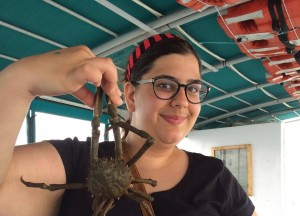 By Emily Nocito
By Emily Nocito
Sustainability Studies Program ’16
Coastal Environmental Studies Major
Ecosystems and Human Impact Minor
My Road to the 2015 ESA Centennial Conference
Last summer I embarked on a research project, that I later titled “The Management Practices and the Status of the Village Ponds in Chilika Lagoon Area, Odisha, India.” As I learned more what I was about to start working on, I became very excited to have my own research experience studying real-life “ecosystems and human impact!”
The village ponds mentioned in the title of my research project are the small water bodies people in Odisha, India, constructed to keep the freshwater or rainwater during the monsoonal season. Generally, this kind of water harvesting system is considered pretty common. However, the thing that make these “village” ponds in this specific area of India special is that the community shares the ponds and developed their own system of managing them. There are three to four ponds usually located in the middle of the village, and shared by around 200 to 300 people. Furthermore, the evidences of having shared community ponds can even be found in ancient Indian literature—from 3,500 years ago! I identified approximately 6,000 ponds in the study area using satellite images. (Just for comparison, the study area is a little over 1,701 square miles in size, while Long Island is just 1,401 square miles in size.) Yet, no one in India was previously interested in studying the ponds, which makes this opportunity more special and significant for me personally.
Currently, I am an Ecosystem and Human Impact major minoring in geospatial science. However, when I began my research, I was not yet minoring in geospatial science. Also, when I began, I only had experiences with the most basic courses of my major, such as “Introduction to Sustainability Studies” and “Introduction to Human Geography.” So, I had to learn how to study the ponds using various scientific methods, such as GIS (Geographic Information Systems) programs to draw maps of the nearly 6,000 ponds in my study area, and then correlate them to other important geographical features.
When I started my research, I stayed in the rural area of Odisha for about a month, visiting many nearby villages to learn more about the village ponds through my own surveys. (Odisha is one of the 29 states of India, located in the east of India.) My primary goal of the study was to understand the distributional pattern and the usage pattern of the village ponds. I created a questionnaire based on other research and literature I found that described how some people use village ponds in general—but they did not take into consideration the local culture in Odisha. Thus, I had to correct the majority of the questions so they fit the Odisha people’s lifestyle and culture, which—stricken with poverty—was heartbreaking to see.

Communicating with people who speak a language different than those I speak was not easy. But, the local people were very kind and happy to try.
After the correction, I approached the local people (who don’t speak any of the languages that I speak) to conduct the survey. It was such an eye-opening experience to me. People were using the little, somewhat even dirty-looking, ponds that I would never even touch for so many different purposes, from religious festivals to irrigation for agriculture to aquaculture, and even for domestic purposes, like washing dishes. It was clear to me that the ponds were very closely related to their everyday life. They literally can’t live without them. Over time, the people learned how to make the ponds more sustainable by creating rules and schemes to help make the ponds cleaner and healthier.
This opportunity led me to another bigger opportunity that I’m going to have: a presentation at an academic conference. I will be attending the centennial meeting of the Ecological Society of America (ESA) this August. I am very excited to share the results of my research with other people who study various fields of ecology professionally.
The most important thing I learned from this research (and soon-to-be presentation) experience is the importance of seeing things from many diverse perspectives. I could not have even approached to this research subject without learning more about the idea of sustainability and the impacts we as humans are creating and receiving. Once again, I realized how important it is to see one thing from various perspectives and combine those ideas to see another side of the subject we haven’t seen before. Sustainability is not a new theme to this world. Perhaps some parts of it are new, however, the lifestyle that allowed us to communicate with out nature with our culture is not. I think it is very important to know about the connections we’ve built before with nature, and approach to the fundamental ideas of sustainability by learning about it for the sustainable and healthy future.
By Evan (Hogyeum) Joo
Sustainability Studies Program ’17
Ecosystems and Human Impact Major
Geospatial Science Minor





